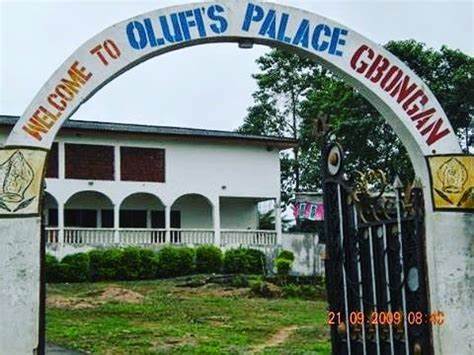Every Yoruba town has its landmark. Gbongan is a junction town, a mini melting pot, and a melting point. Founded by an Oyo Prince named Olufioye (shortened to Olufi), Gbongan is steeped in rich history and culture.
Olufioye was a direct descendant of Alaafin Abiodun Adegoriolu, who reigned in Oyo from 1770 to 1789. Despite being a prince, Olufi contested for the throne of the Alaafin of Oyo after the demise of his father but lost to another prince, Aole. Following this, he left Oyo with many sympathizers and journeyed through the Igbori route, ultimately settling in Soungbe, where they established Gbongan-Ile. He brought with him a beaded crown and coral beads (Ileke Orun), marking his recognition as an Oyo Prince and an Oba in his own right.
The unrest that plagued the Oyo empire affected many towns, leading Olufi and his followers to migrate to a more secure forested area, which is now Gbongan, situated within the forest belt of Osun State. This area now includes settlements like Oke-Egan, Oke Apata, and Ile-Opo, with a network of streams nourishing the town, including Oyunlola, Akinjole, and Yemoja.
Gbongan thrived as a cosmopolitan and peaceful junction city. Its strategic location—forty miles from Ibadan, thirty miles from Oshogbo, and nineteen miles from Iwo—made it a vital commercial hub. The Gbongan–Iwo–Iseyin route opened access to Oke-Ogun, a food basket of the Yoruba nation, and the Owu kingdom, connecting directly to the Atlantic via Ejinrin waters, a key location for European trade in the 18th and 19th centuries. Additionally, it served as a critical connection to Ile-Ife, the home of Oduduwa, founder of the Yoruba race.
Commerce flourished in Gbongan due to its advantageous position, drawing various tribes and communities, including Ijebu, Ilesha, and Hausa settlers. The town became a bustling marketplace for prominent businesses like John Holt, UAC, and Patterson Zochonis, contributing to its reputation as a beehive of activity.
The legacy of Gbongan is intimately tied to Alaafin Abiodun Adegoriolu, renowned for his progressive reign that brought peace and prosperity to the Oyo empire. His influence extended beyond the region, reaching as far as Dahomey and parts of Ghana. He was a beloved figure, remembered through songs that celebrated the Oyo empire’s affluence during his reign.
One notable event in Gbongan’s history is when Ooni Adenekan Sijuwade Olubuse I traveled through Titi Gbongan in 1903. During his journey to Lagos, traditional practices dictated that all Obas, including the Olufi of Gbongan, pay homage, showcasing the significance of Gbongan in Yoruba royalty.
Titi Gbongan became a crucial route for inter-city and intra-state travel, where passengers would stop to refresh themselves at various eateries and shops, further enriching the town’s economic landscape. Philosophical inscriptions on the vehicles passing through Titi Gbongan, such as “Owó Tútù” (Cold Money) and “Ìwà Pẹ̀lẹ́” (Calm Character), reflected the cultural essence and morals of the people.
Cultural events thrived in Gbongan, with venues like Omo-Ekun Hotel & Bar hosting performances by prominent theatre groups, including Hubert Ogunde’s “Yoruba Ronu,” and serving as a hub for film screenings organized by the Western State government.
The Palace of Olufi Asabi, built by the progressive Olufi Adewale Asabi, is now recognized as a national monument, embodying the architectural grandeur of Gbongan’s history.
As we reflect on the legacy of Gbongan, it is clear that this town, with its rich tapestry of history, culture, and commerce, remains a landmark not only in the geographical sense but also in the heart of the Yoruba nation.



